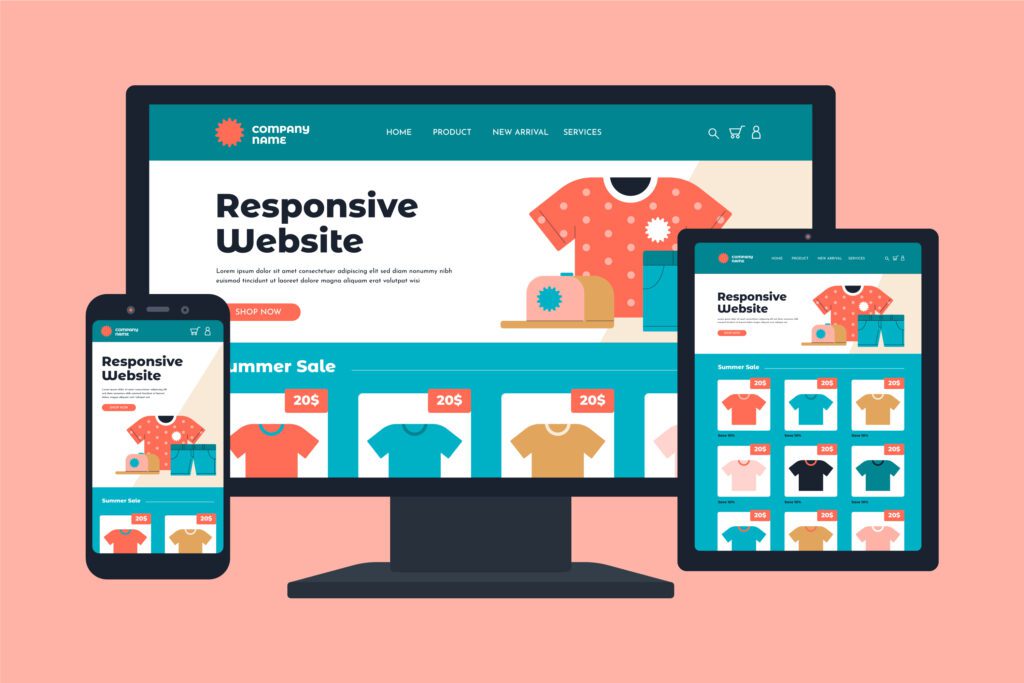In the fast and dynamic world of e-commerce, your website is the center of your business representing the point of reference for your online presence. Thus, They act more than a static digital storefront namely a dynamic platform that captures the entire essence of your brand to enable meaningful customer engagements. It also refers to the primary conduit through which sales and revenue will be driven.
Your website represents the virtual front of your brand identity, value, and ethos. Every aspect of design, right from the layout and color scheme to the typography and imagery, should resonate harmoniously with your brand’s main narration. Where your physical storefront represents a concrete version of your brand’s identity, the e-commerce website serves as an extended digital copy of brand identity to deliver an experience ready for your business’s core audience.
Moreover in today’s digital landscape where attention spans are shrinking and there is this fierce competition on the other hand, so much of it depends on making a first positive impression. Studies also suggest that users take milliseconds to judge the credibility of a site once they land on it. In this sense, the design and usability of your e-commerce site are pivotal in forming the customers’ perception and eventually making a purchase.
In this blog, we shall take you through a number of tried and tested strategies that are meant to make your e-commerce website design impeccable. Below are strategies given that have been very well thought out and fine-tuned to help create a digital storefront that does more than just woo visitors but encourages engagement and converts better. So let’s dive in and look at how you can up the game with your e-commerce website design.
- Designing for User Experience (UX)
User experience (UX) is the bedrock of all good website design. Far more important than aesthetics, it looks at the experience of users as they move around a site. It includes ease of use, intuitiveness, and accessibility – all these parameters play a crucial role in defining the way with which visitors perceive and interact.
- Simplicity:
Do not make them overwhelmed by the information or options. Try to narrow down your layout to only important elements and not too many things around.
- Intuitive navigation:
Develop a clear and logical navigation menu design that helps users find what they’re looking for easily and quickly. Group related categories and products using meaningful descriptive labels to the target users.
- Smart Search Feature:
You can provide an improved search option on the site. With the help of this feature, the search query gets guessed, and hence relevant results to the search are shown. This way, users can find the required products easily without much hassle, especially when they are very keen on making the purchases.
- Match Brand Identity
Ensure that the website has the personality, values, and unique selling propositions of your brand. Consistency across each and every site element would help reinforce your brand identity and increase your audience’s trust in you.
- Aesthetics: choose color scheme, fonts, and images in accordance with your brand; see how the chosen ones trigger particular feelings, impressions that will be subject to the appeal of your target audience.
- Messaging: Develop in words that fully capture your target audience and narrate the story of your brand. Show language that resonates with the tone, values, and value propositions of your brand.
- Values: Bring to life in the web design the values that represent your brand, such as quality, sustainability, or social responsibility.
- Stay Up-to-Date with Trends
In the fast-changing world of e-commerce, from new technologies to innovations in marketing and evolving consumer behaviors, staying ahead of trends allows businesses to evolve with the times.
- Interactive Layouts:
Make your customers interact with those fancy elements as animations, quizzes, or product configurators. They will contribute not only to the usability of your site but also make it more memorable. - Dynamic Pages:
Try out dynamic content that adjusts with the behavior or choice of users. Recommendations for previously bought or browsed products can include suggestions such as recommended products or upsell items, adding to better conversions and sales. - Social Commerce:
Social media is a platform that provides another marketing avenue. It becomes an extension of the sales channel for your customers. Add social commerce features to your site—for instance, shoppable Instagram feeds or a Facebook storefront—to extend your reach and draw in sales.
- Optimize for Mobile
With the growth in the wave of mobile shopping, optimizing your e-commerce site for mobiles is a must. With the number of customers these days turning to their smartphones and tablets for browsing and making purchases, making your site mobile-friendly really should be an ongoing priority to provide a seamless and engaging shopping experience.
- Responsive Design:
When ensuring that your site is by nature responsive, it refers to the one that will entertain even the smallest of variations in terms of screen sizes or different devices. This will bring about a uniform experience whether accessed through the desktop, smartphone, or tablet. - Mobile-Friendly Features:
Easy navigation with reduced load times for mobile users. It optimizes images for mobile viewing and ensures the size of the tap buttons and links are large enough for the finger to tap comfortably. - Mobile Payment Options:
Integrate a possibility for customers to pay through their mobile phones with options like Apple Pay and Google Pay or mobile wallets. This will make the checkout process smoother and, as a result, your mobile users will experience lower friction.
- Incorporate Customer Reviews
Use customer reviews and testimonials as a way to gain the trust of your customers and influence their purchase.
- Display Reviews Prominently:
Display customer reviews on the product pages to assist customers in making the right selection. Include star ratings and user-written reviews, along with user-posted photos or videos to bring even more context and credibility. - Encourage User Feedback:
Encourage your users to leave reviews by sending them follow-up emails after the purchase. Offer them incentives to review your product. Another way to react to the reviews is to demonstrate your appreciation for such customer feedback.
- Simplify the Checkout Process
Simplifying your checkout process is very vital to reducing your cart abandonment and boosting your conversion rate in e-commerce. You make a frictionless experience that will prompt customers to complete their transaction by reducing the number of steps that customers should make to complete a purchase and eliminating unnecessary distractors.
- One-Page Checkout:
Make the checkout process a one-pager, requiring only the most essential details—shipping and payment, and ensure clear pointers all the way through to cut down on steps and make it as easy and direct as possible. - Clear CTAs:
Provide clear and compelling call-to-action (CTA) buttons that help users navigate through the checkout process. Buttons such as “Add to Cart” or “Proceed to Checkout” should be visually clear and prominently placed to encourage action. - Multiple Payment Options:
Available payment methods should be multiple and optional for the customer to pay as per his/their convenience. It may include credit/debit cards, PayPal, digital wallets, or buy now, pay later services.
- Incorporate Trust Signals
Incorporate trust signals to your e-commerce website in order to increase credibility and convince prospective customers.
- Professional Imagery:
Use high-quality pictures and professional photography of your products when displaying them to give your products every edge. It will help in visualizing the product, and customers can feel confident about the purchase decision.
- Contact Information:
Add clear contact information that has an email, phone number, and physical address to make it easier for the customer to get in touch in case of any questions or any assistance needed.
- Transparent Policies:
Clearly specify your store policies, including shipping, and return and privacy policies. Displaying this information upfront goes a long way in gaining the customers’ trust with less ambiguity, showing that your store is all for transparency and customer service.
- Security Certifications:
Show such trust badges and security certifications which may make the customers feel their personal and financial information is safe. It may include SSL certificates, logos of payment processors, and any other industry-specific certifications your site may have that give your customers peace of mind and shop with confidence.
Final Takeaway
At the end, we want to introduce e:command that truly believes in the realization of effective e-commerce website design that stretches further than aesthetic pleasure. e:command as an e-commerce store developer and website design service provider understands about crafting a seamless user experience, building a strong brand identity, and earning trust with your audience. Any of these strategies can lift your digital storefront and reveal new opportunities in the highly competitive e-commerce world. Get in touch with us today, so that you can have the breakthrough move with utmost certainty in your e-commerce venture.





